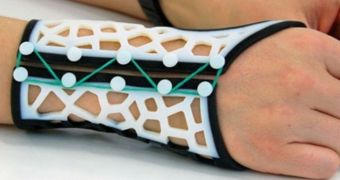Splints are an essential part of treating arm injuries or conditions likes arthritis, but a researcher from the University of Loughborough has decided that they can be improved, both in terms of usefulness and when it comes to comfort and aesthetic value.
Comfort is mostly a secondary concern in doctors' minds. After all, healing their patients comes first, and if it takes a stiff or itchy arm to achieve it, it's a small sacrifice. For the most part, patients themselves agree.
Abby Paterson, the PhD student at the University of Loughborough, decided to try and enable some measure of comfort and beauty regardless. After all, a less itchy skin patch is one less chance of you shifting your splint or cast and setting your healing back by days.
She has invented a program that will let doctors customize the appearance or shape of splints, allowing them to provide their patients with slimline, breathable healing tools.
Even medics with no real experience or knowledge of CAD (computer-aided design) software should find the program easy to use, improving aesthetics, the fit, and even add extra functionality if it strikes their fancy or that of the people under their care.
In fact, it is possible to include rubber hinges, padding, and other elements without compromising the effectiveness or endurance. The Objet Connex 3D printer used to make it always prints it integrally, and one-piece items always withstand time and handling better than segmented ones.
A side-effect of the technology and materials used (plastics) is that the splints are lighter, as well as cheaper to produce. Add to that the customizable color, fastenings, and lattice work and people will be more likely to wear them the way their doctors instruct, instead of taking them off in public or in front of visitors.
Integrated rubber borders were one option for increased comfort that practitioners were “very excited about,” according to Paterson.
The splints that Paterson has made so far using her software can help treat wrist rheumatoid arthritis, which affects around 400,000 people from the United Kingdom alone.
The program is not ready yet, however. Despite her diligence and the help of Richard Bibb, also of Loughborough University, she does not expect the CAD software to be ready for use in hospitals for another 18 months or so. They also need some funds to finish it, but considering the huge demand for the service that the program promises to provide, investors probably won't be hard to find now that the invention has made the news.

 14 DAY TRIAL //
14 DAY TRIAL //